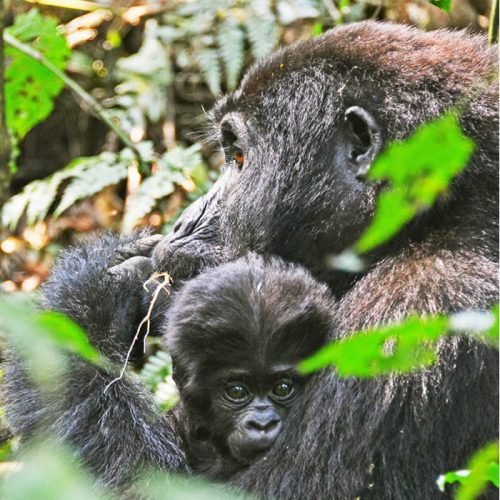Nestled in the lush highlands of southwestern Uganda, Bwindi Impenetrable National Park is one of Africa’s premier wildlife destinations. Renowned for its critical role in the conservation of the endangered mountain gorilla, this UNESCO World Heritage Site offers a truly unforgettable experience for wildlife enthusiasts and nature lovers. With over 1,050 mountain gorillas left in the wild and more than half of them residing in Uganda, Bwindi provides an unparalleled opportunity to witness these majestic creatures in their natural habitat.
A Haven for Mountain Gorillas
![]() Bwindi Impenetrable National Park was first designated as a forest reserve in 1942 and later established as a national park in 1992. Recognized as a World Heritage Site in 1994, Bwindi is aptly named from the local Lukiga language, where ‘Bwindi’ means ‘Impenetrable’. This name reflects the park’s dense, rugged terrain—327 square kilometers of tangled vegetation covering steep, challenging valleys and lofty ridges. Trekking through this ancient rainforest in search of the mountain gorillas is considered one of the world’s premier wildlife experiences.
Bwindi Impenetrable National Park was first designated as a forest reserve in 1942 and later established as a national park in 1992. Recognized as a World Heritage Site in 1994, Bwindi is aptly named from the local Lukiga language, where ‘Bwindi’ means ‘Impenetrable’. This name reflects the park’s dense, rugged terrain—327 square kilometers of tangled vegetation covering steep, challenging valleys and lofty ridges. Trekking through this ancient rainforest in search of the mountain gorillas is considered one of the world’s premier wildlife experiences.
The Four Gorilla Sectors
Bwindi is divided into four key sectors, each offering unique opportunities for gorilla trekking:
- Rushaga Sector: Located in the southern part of the park, Rushaga is renowned for its diverse gorilla families and is known for the high likelihood of encountering gorillas in their natural habitat. The terrain here is a bit less challenging, making it a favorable option for many trekkers.
- Ruhija Sector: Positioned in the northeastern region, Ruhija is characterized by its diverse landscapes and is home to several habituated gorilla families. The area offers a variety of trekking experiences and is also noted for its scenic beauty.
- Buhoma Sector: As the oldest and most established sector, Buhoma is located in the northern part of Bwindi. It is home to several of the park’s most famous gorilla families and provides an excellent introduction to the gorilla trekking experience.
- Nkuringo Sector: Found in the southwestern corner of Bwindi, Nkuringo is known for its steep and rugged terrain. The sector offers a more challenging trek but rewards visitors with breathtaking views and close encounters with the park’s gorilla families.
Climate and What to Expect
 Bwindi’s weather is characterized by cool temperatures and frequent rainfall. The average annual temperature ranges from 7°C to 20°C, with the coldest periods occurring in June and July. Due to the park’s high rainfall—up to 2,390 mm per year—visitors should come prepared with warm clothing and waterproof gear. Rain is most common during the short rains (March to May) and the heavy rains (September to November).
Bwindi’s weather is characterized by cool temperatures and frequent rainfall. The average annual temperature ranges from 7°C to 20°C, with the coldest periods occurring in June and July. Due to the park’s high rainfall—up to 2,390 mm per year—visitors should come prepared with warm clothing and waterproof gear. Rain is most common during the short rains (March to May) and the heavy rains (September to November).
Biodiversity and Wildlife
Bwindi Impenetrable National Park is a treasure trove of biodiversity. Its ancient forest harbors a remarkable array of species, including over 310 butterfly species, 51 reptiles, 200 tree species, 88 moth species, and 120 mammal species, including 10 primates. Among these, the mountain gorilla stands out as the park’s most famous resident.
Birdwatchers will find Bwindi particularly rewarding. The park is home to 350 bird species, including seven listed by the IUCN and 90% of all Albertine Rift endemics. Experienced birders can identify up to 100 species in a single day.
Local Communities
The communities surrounding Bwindi are primarily Bafumbira, with a small population of Batwa (Pygmies) living in the area. The Bwindi region is one of Uganda’s more sparsely populated areas, with a density of about 350 people per square kilometer. Visitors can engage in nature walks to explore the neighboring communities, participate in cultural performances, and enjoy community dances.

